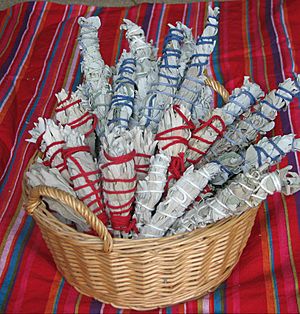Smudging facts for kids
Smudging, or other rites involving the burning of sacred herbs (e.g., white sage) or resins, is a ceremony practiced by some Indigenous peoples of the Americas. While it bears some resemblance to other ceremonies and rituals involving smoke (e.g., Australian smoking ceremony, some types of saining) from other world cultures, notably those that use smoke for spiritual cleansing or blessing, the purposes and particulars of the ceremonies, and the substances used, can vary widely among tribes, bands and nations, and even more so among different world cultures. In traditional communities, Elders maintain the protocols around these ceremonies and provide culturally specific guidance. The smudging ceremony, by various names, has been appropriated by others outside of the Indigenous communities as part of New Age or commercial practices, which has also led to the over-harvesting of some of the plants used in ceremonies. The appropriation and the over-harvesting have both been protested by Indigenous people in the US and Canada.
Native American traditions
In some Indigenous American and Canadian ceremonies, certain herbs are traditionally used to purify or bless people and places. For instance, some cultures use the smoke of burning red cedar as part of their particular purification and healing ceremonies. Sometimes this is done in hospitals to "cleanse and repel evil influence." However, the same herbs that are burned by one culture may be taboo to burn in another, or they may be used for a completely different purpose. When specific herbs are burned ceremonially, this may or may not be called "smudging", depending on the culture. Traditionally, when gathering herbs for ceremonial use, care is taken to determine the time of day, month, or year when the herbs should be collected; for example, at dawn or evening, at certain phases of the moon, or according to yearly cycles. Gertrude Allen, a Lumbee, reported that her father, an expert in healing with plants, stated that sage varies in potency at different times of the year.
While sage is commonly associated with smudging and several Native American, First Nations, Inuit or Métis cultures may use forms of sage that are local to their region, the use of sage is neither universal, nor as widespread as many believe. Its use in regions that have not traditionally used sage for purification is largely a result of the Pan-Indian movement, rather than traditional practice. In some cases it may be in direct opposition to what is traditional for that region. Likewise, not all Native American or Indigenous Canadian cultures that burn herbs or resins for ceremony call this practice "smudging".
While using various forms of scent and scented smoke (such as incense) in religious and spiritual rites is an element common to many different cultures worldwide, the details, reasons, desired effects, and spiritual meanings are usually unique to the specific cultures in question.
Use of smoke in other cultures
Other cultures worldwide may burn herbs or incense for spiritual purposes, such as in smoking ceremonies, some forms of saining, or practices involving the use of incense censers. However, these cultures have their own practices, as well as their own beliefs about these ritual actions and the ritual use of smoke.


